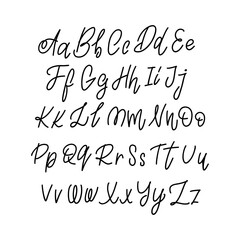
PC: Adobe Stock
The cursive alphabet is one of the first things young students encounter when learning cursive.
Starting in third grade, my teacher would spend thirty minutes every day, passing out worksheets and tracing fluid lines across the whiteboard. This mesmerized me, the writing on the board displaying a stream of thoughts, lacing the letters together to create beautiful and intricate words from something so small.
The idea that writing could be done in this style, with such poise and fluency, shocked me to my core and changed the way I thought of the written word forever.
As I tirelessly traced the dotted lines of worksheets, creating small letters that I knew could be something more with time and patience, my classmates groaned with boredom and despair. The idea that we had to learn a whole new style of writing when we spent so much time learning print was nothing but redundant.
On top of that, the style of cursive itself made no sense to the simplistic minds of the third-grade student body. A lowercase z contained more swoops than a rollercoaster, a lowercase m suddenly had 3 humps, and an uppercase G doesn’t even remotely resemble what a printed uppercase G looks like.
Despite these trials and oppositions, I saw the beauty in the vintage style words, relishing in the meticulous details and going back to cross every t and dot every i. The squiggles evolved into basic letters, and eventually something more, as we began to understand the endless jumbles of pencil marks that used to mean nothing.
Mastering cursive felt like a rite of passage, as it taught the skills required to develop your own signature that could be used to write your name on all the assignments that we had seen from the older students. By signaling that we had obtained that mode of higher knowledge, we thought that the world would finally see us as mature and wise.
Cursive has been used for generations as a means of communication and standard writing in the past, but recently it has developed into a further mode of teaching the youth fine motor skills that help improve not only their hand-eye coordination, but their standard handwriting as well.
As my peers and I learned this sacred and complex fashion of writing, I noticed that many students chose never to use it other than signing their name on a permission slip or document. Cursive writing quickly stepped out of the spotlight and was stored in the back of our brains as young students, with it being nothing more than a skill we were briefly tested on in primary school.
Nowadays, many students claim that they no longer remember how to interpret and effectively use the cursive they learned all those years ago, struggling to read simple phrases or recall how to write a short sentence in a specific style.
The very concept that had been taught to us, stressing the importance of brain retention and memory proficiency, lost all of its meaning as the world evolved, and the disappearance of this educational opportunity has even been shown in the most recent studies from the generations who never learned cursive.
With this lack of knowledge, students missed the engagement and patience it took to master the skillset that was required, and they never stretched the limitations of their minds to comprehend something that wasn’t immediately simplified for them.
The reliance on technology that has increased in recent years has been a leading factor in the decline of cursive used in an academic and domestic setting, since kids can simply type a sentence rather than take the time to carefully write out the letters and connect the words by hand to craft a structured sentence on paper.
By not teaching the fundamental aspect of cursive and substituting it with a course on typing, the quality of students’ handiwork has decreased, especially their handwriting. This is one of the key reasons behind students struggling when having to write out notes or assignments, since they were never taught the patience or skillset to handwrite long passages in a time-effective and neat manner.
By teaching students cursive in schools, we can instill the continuation of the written word using pen to paper, doubling as a way to increase the ability of students’ fine motor skills. Presenting a new and slightly challenging informational idea to the students will help to strengthen their memory and information retention through high engagement and inclusion.
Even with a backseat in common writing practices, cursive should never go completely out of mind, because of its deep and influential presence in historical records.
The majority of the influential and critical historical documents were written in cursive, and losing the ability to read cursive will prove to be a detrimental mistake when future generations lose their sense of historical literacy and interpretation from simply not being able to read and comprehend the documents.
Learning how to read and write in cursive can open up doors to future generations, as they learn to not only decipher what happened in the past, but also develop a better mindset and understanding of literacy for the future.